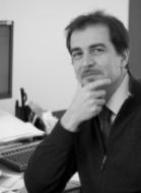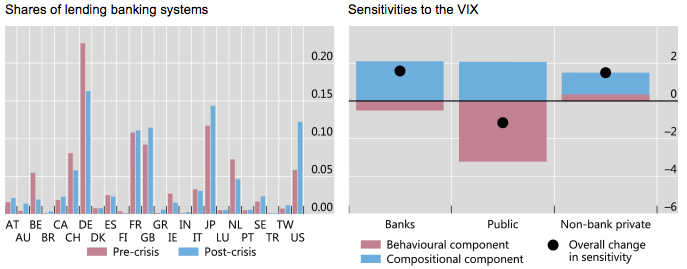Global factors, including the monetary policy of advanced economies and global risk sentiment, are important drivers of international capital flows (Forbes and Warnock 2012, Miranda-Agrippino and Rey 2015, Cerutti et al. 2017a, Cerutti et al. 2017b). But how does the sensitivity to such global factors evolve? We study this issue in a recent paper (Avdjiev et al. 2017). One key result is that the two main global liquidity components – cross-border bank loans and international debt securities – became substantially more responsive to US monetary policy in the immediate aftermath of the Global Crisis, then partially reverted back to recent historical patterns. Another set of key findings is the evolving responsiveness of global liquidity with respect to global risk conditions and the reasons for these changes. In this column, we demonstrate that the sensitivity of cross-border lending to global risk conditions declined considerably post-crisis and became similar to that of international bond issuance, largely reflecting a change in the composition of international lenders.
New evidence on the shifting drivers of global liquidity
The structure and volatility of cross-border bank loan and international bond flows have changed considerably in the aftermath of the Global Crisis (left-hand panel of Figure 1). Cross-border loan flows contracted sharply, and then made a feeble recovery before a second sharp contraction during the euro area crisis. International bond issuance was much more stable.
One factor at play has been the increased sensitivities of individual banking systems to the accommodative monetary policy of advanced economies in the immediate aftermath of the crisis. Using the Bank for International Settlements (BIS) international banking and debt securities statistics for a quarterly panel of 64 countries over 16 years, we show that this effect was transitory, and gradually weakened when the monetary policies of advanced economies started to diverge in 2013.
Figure 1 Global liquidity and global factors
Notes: 1 IDS = International Debt Securities: Quarterly Growth Ratet = (Outstanding Stockt / Outstanding Stockt-1)-1; XBL = Cross-border loans: Quarterly Growth Ratet = (Outstanding Stockt / Outstanding Stockt-1)-1. 2 BEX (2017) = Bekaert et al. (2017).
Sources: Bekaert et al. (2017); Datastream; BIS locational banking statistics and international debt securities statistics; authors’ calculations.
The key parameter in our econometric analysis captures the sensitivity of cross-border loan or bond flows to global risk conditions.1 We estimate this sensitivity separately before and after the first quarter of 2009, which statistical tests identify as the timing of a ‘structural break’ in the relationship between global liquidity flows and its drivers. In our benchmark estimation, we use the VIX as a measure for global risk conditions. We obtain very similar results when using the Bekaert et al. (2017) risk index, as the two measures are strongly positively correlated (right-hand panel, Figure 1).
Global liquidity became less sensitive to global risk conditions
Both cross-border loans and international bonds have become considerably less sensitive to global risk conditions since the Global Crisis. The estimated effect of the VIX, which was negative and highly statistically significant prior to the crisis, weakened steadily during the post-crisis period and became insignificant by the end of the sample (i.e. in the fourth quarter of 2015).
Figure 2 displays the evolution of the post-break sensitivities of cross-border loans and international debt securities to global risk conditions. The dashed red horizontal line in each panel represents the pre-break estimate of the sensitivity to global risk conditions, estimated over the period between 2000Q1 to 2008Q4. The black lines are time-varying post-break estimates of the same sensitivity, obtained by adding one quarter at a time to the initial post-break sample (2009Q1 to 2013Q1) up to 2015Q4.
The post-crisis period saw a steady decline in the estimated sensitivity of cross-border loans to global risk conditions. The impact of a one-standard deviation increase in the VIX on the quarterly growth rate of cross-border bank lending declined from 134 basis points prior to the Global Crisis to 91 basis points during the period between the Global Crisis and the 2013 Fed ‘Taper Tantrum’. This brought the risk-sensitivity of loan flows very close to that of bond flows, whose estimated response to a one-standard deviation VIX increase during the 2009-2013 period was 104 basis points, up from 37 basis points prior to the GFC.
The post-2013 period saw steep declines in the estimated sensitivities to global risk of both bank and bond flows. Once the sample is extended to 2015Q4, the estimated impact of a one-standard deviation increase in the VIX falls to only 11 basis points for loan flows and to 53 points for bond flows. These findings are in line with the argument of Shin (2016) that the VIX has lost its power as a barometer of banks’ appetite for leverage since the Global Crisis.
Figure 2 Post-break sensitivities to global risk conditions, evolution over time
Notes: The graph shows the evolution over time of sensitivities to the log(VIX). For each quarter t, the panels show the post-break coefficient (and its 90% confidence interval) obtained by estimating the model with a sample from 2000Q1 up to quarter t, with a break in 2009Q1. The dotted red line in each panel represents the pre-break estimate of the sensitivity to the log(VIX).
Source: Authors’ calculations.
Reasons for the post-crisis shifts in global risk sensitivities
These changes, which are estimated from the perspective of borrowing countries, could reflect compositional changes (shifts in the market shares of lending banking systems), behavioural changes (changes in lending banking systems’ sensitivities to global risk), or both. We gain insight into the relative importance of the above potential drivers in cross-border lending by utilising additional bilateral (lender/borrower country-level) data from the BIS consolidated banking statistics in order to estimate country-specific sensitivities for a cross-section of 30 lending banking systems. These data allow us to identify the role of compositional versus behavioural factors in driving changes in overall risk responsiveness from the perspective of borrowing countries.
The left-hand panel of Figure 3 presents the lending national banking system weights for the pre- and post-crisis periods. It illustrates that the post-crisis period has seen a decline in the international lending shares of euro area banks and an expansion in the respective shares of banks from advanced economies outside the euro area. The above general pattern tends to hold for international lending to the bank, and non-bank private and public borrowing sectors.
Further analysis shows that banking systems that were better capitalised before the crisis were more likely to experience larger increases in their international lending market shares post-crisis. These findings are in line with Gambacorta and Shin (2017), who show that well-capitalised banks are perceived as less risky by depositors and other creditors, have easier access to funding, and are consequently less sensitive to fluctuations in funding costs. International lending market shares also increased for banking systems that had greater reliance on deposits funding and traditional income sources, as well as for those with a larger portion of foreign lending booked locally by foreign subsidiaries and branches.
Additional decompositions reveal that the compositional component (i.e., changes in lender market shares) is the main driver of the declines in the risk-sensitivities of international bank flows (as captured by the estimated impact coefficients becoming less negative). As the right-hand panel of Figure 3 illustrates, the compositional component (blue bars) has significantly reduced the sensitivities to global risk for lending flows to all three borrowing sectors. In contrast, the contribution of the behavioural components (red bars) is negligible for international lending flows to banks and to the non-bank private sector and negative (increasing the absolute value of the sensitivity) for lending to the public sector.
Figure 3 Decomposing the shifts in lender-specific sensitivities
Sources: BIS consolidated banking statistics; authors’ calculations.
Conclusions
The sensitivity of international bank lending to global risk conditions declined in the years following the Global Crisis, a phenomenon that occurred alongside an initial increase in sensitivity to the monetary policies of advanced economies. This decline is mainly due to a compositional effect, driven by increases in the lending market shares of better-capitalised national banking systems, which tend to be less responsive to fluctuations in global risk conditions. Initiatives to make banking systems more robust in advanced countries, for example through prudential instrument changes and policies aimed at boosting capitalisation and stable funding levels, may have had the positive side effect of reducing the amplitude of fluctuations in key components of international capital flows in response to swings in risk sentiment.
References
Avdjiev, S, L Gambacorta, L Goldberg and S Schiaffi (2017), “The shifting drivers of global liquidity”, BIS, Working Papers, 654; NBER, working paper 23565; Federal Reserve Bank of New York, staff reports 819; CEPR, Discussion Paper 12217.
Bekaert, G, E Engstrom and N Xu (2017), “The time variation in risk appetite and uncertainty”, Columbia Business School, Research Paper 108.
Cerutti, E, S Claessens and L Ratnovski (2017a), “Global liquidity and drivers of cross-border bank flows”, Economic Policy 32(89): 81–125.
Cerutti, E, S Claessens and A K Rose (2017b), “How important is the financial cycle? Evidence from capital flows”, BIS, working papers 661.
Forbes, K J and F E Warnock (2012), “Capital flow waves: Surges, stops, flight, and retrenchment”, Journal of International Economics 88(2): 235–251.
Gambacorta, L and H S Shin (2017), “Why bank capital matters for monetary policy”, Journal of Financial Intermediation, forthcoming.
Miranda-Agrippino, S and H Rey (2015), “World asset markets and the global financial cycle”, NBER, working Paper 21722.
Shin, H S (2016), “The bank/capital markets nexus goes global”, speech at the London School of Economics and Political Science, London, 15 November.
Wu, J C and F D Xia (2016), “Measuring the macroeconomic impact of monetary policy at the zero lower bound”, Journal of Money, Credit and Banking 48(3): 253–291.
Endnotes
[1]In our baseline equation, the dependent variable is the quarterly growth rate of either cross-border loans or international bonds, each broken down by borrowing sector (banks versus nonbanks). The right-hand side of the equation contains the log of the VIX, our volatility measure of global risk conditions, and other controls such as the quarterly change in the Wu and Xia (2016) shadow rate for US monetary policy, global GDP growth, and a complete set of country fixed effects and variables reflecting local conditions.










